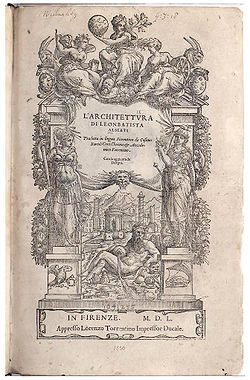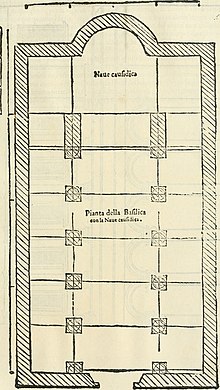De re aedificatoria
De re aedificatoria (On the Art of Building) is a classic architectural treatise written by Leon Battista Alberti between 1443 and 1452.De re aedificatoria is subdivided into ten books and includes: In his survey of desirable floor plans for sacred buildings – "temples" in his phrase—Alberti begins with the ideal form of the circle, which is expressed in numerous examples of Nature.Chapels add small geometric figures to the basic circles and polygons to give a great variety of floor plans, in which each geometrical figure retains its clear unity and simple ratios that bind all elements of the plans and elevations into a harmonic unity.In Book Nine, Alberti presents his comments about aesthetic theory and beauty which Borsi summarizes on page 234 of his Alberti book stating: "In short, what are the elements that constitute beauty?Quoting Alberti, Borsi presents Alberti as stating: "For whatever that property be which is chosen from the whole number and nature of the several parts or attributed to each of them in precise and equal measure, or which must be such as to form a single entity of organism out of a number of parts, binding them together in a just, stable and harmonious manner... it must certainly contain within itself the value, I would almost say the essence of all the above-mentioned parts with which it is connected or which it compenetrates.


Leon Battista AlbertiVitruviusDe architecturaItalian RenaissancebasilicaMathematics and architectureMathematics and artAristotlesociologyarchitectureDe picturaI quattro libri dell'architetturaWayback MachineTempio Malatestiano, RiminiSanta Maria Novella, FlorenceSan Sebastiano, MantuaSant'Andrea, MantuaSantissima Annunziata, FlorencePalazzo Rucellai, FlorenceRucellai SepulchreSan Pancrazio, FlorenceAlberti cipherThe Age of the MediciAlgorithmCatenaryFractalGolden ratioHyperboloid structureMinimal surfaceParaboloidPerspectiveCamera lucidaCamera obscuraPlastic ratioProjective geometrySymmetryTessellationWallpaper groupAlgorithmic artAnamorphic artGeodesic domePyramidVastu shastraComputer artFiber arts4D artFractal artIslamic geometric patternsMuqarnasZellijKnottingCeltic knotCroatian interlaceInterlaceOrigamiMathematicsSculptureString artString figureTilingList of works designed with the golden ratioContinuumMathemalchemyOctacubePi in the SkyBuildingsCathedral of Saint Mary of the AssumptionHagia SophiaKresge AuditoriumPantheonParthenonPyramid of KhufuSagrada FamíliaSydney Opera HouseTaj MahalArtistsPaolo UccelloPiero della FrancescaLeonardo da VinciVitruvian ManAlbrecht DürerParmigianinoSelf-portrait in a Convex MirrorWilliam BlakeThe Ancient of DaysNewtonJean MetzingerDanseuse au caféL'Oiseau bleuGiorgio de ChiricoMan RayM. C. EscherCircle Limit IIIPrint GalleryRelativityReptilesWaterfallRené MagritteLa condition humaineSalvador DalíCrucifixionThe Swallow's TailCrockett JohnsonMax BillMartinErik DemaineScott DravesJan DibbetsJohn ErnestHelaman FergusonPeter ForakisSusan GoldstineBathsheba GrossmanGeorge W. HartDesmond Paul HenryAnthony HillCharles JencksGarden of Cosmic SpeculationAndy LomasRobert LonghurstJeanette McLeodHamid Naderi YeganehIstván OroszHinke OsingaAntoine PevsnerTony Robbin